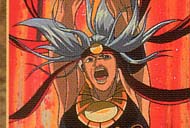
Nazca: Blades of Fate
Formula is key to a lot of Japanese animation. There are certain themes that appear again and again within anime that give viewers a certain set of expectations. One popular example is the formula of the young naive rogue who starts off a hotshot and ends up a hero--this echoes through Macross, Gundam, even the recently released Queen Emeraldas and hundreds of other shows. Another well-known formula is that of the unknown hero or heroine who receives mystical or magical powers in order to battle evil. Sailor Moon, Devil Hunter Yohko, Tonde Boorin all feature this theme...although it is found a lot in shojo titles, it also carries over into shows such as Nazca. What's ultimately important is not the formula itself, but whether the show gets trapped within the boundaries of its formula or is able to find a new and fresh way to deal with its subject matter. Thankfully, Nazca has a few nice surprises that make it stand out from some of its animated brethren.
Nazca starts in present-day Japan as a young kendo student, Kyoji, races to watch his sensei Tate participate in a tournament. He literally runs into Yuka, who turns out to be not only an innocent bystander but also Tate's fiance. As they watch the match, Tate makes an incredible move that literally splits his opponent's armor in two and breaks his ribs--and since kendo is fought with wooden swords, it's nearly impossible!
Kyoji is dismayed because Tate quit his job at the school over the controversy surrounding his tournament performance. However, things are about to get worse. In the midst of the kendo tournament, Tate realized that he is actually the reincarnation of an ancient Incan warrior, and that Kyoji owns the soul of his greatest rival. Kyoji is reluctant to believe that he is indeed a part of this madness. What's more, Tate goes from being mentor and friend to enemy. As Kyoji's friends and family start realizing that they, too, are part of a grand reincarnation of Incan legends, he doesn't know who to trust. Yuka is his only confidant as he travels the world in search of the truth of his soul.
Nazca is surprisingly intelligent and thoughtful for what is advertised as essentially an action-adventure show. Frankly, I enjoyed it much more than I expected, and I found most of the characters likable and sympathetic. It's also unique in that the Incan culture is an unusual thing for an anime story to explore. Besides all of this, the action sequences are exciting and well-conceived; each one feels important in and of itself.
Nazca originated on Japanese TV, and the quality of the artwork is somewhat spotty due to the budget constraints of such. It also occasionally employs computer animation, which is very noticable and not particularly impressive. However, the character designs are nice, and the story itself flows nicely. The pace is not forced or rushed--it feels like you're seeing the story the way it was intended. The first three episodes of the series are contained on the first tape or DVD, and since the show ran 12 episodes in total, it won't be a budget breaker. The third episode does end on a major cliffhanger, though, so if that bugs you, beware to avoid the show until the whole series is available!
Although the series is being released by Pioneer, New Generation Pictures is working in association with them on the dubbing for this show. In an unusual twist, I was actually asked by New Generation to review the dubbed version of this title. Frankly, their request is rare--most companies release dubs since they tend to sell better than traditional subtitles, but it's unusual to find a company that actually wants to promote them among the regular anime audience. As most are well aware, dubs tend to lose a lot not only in translation but in acting style--the best are usually just competent, and the worst are grating. In fact, though I've seen plenty of dubs, I personally don't buy them unless there's a really good reason to do so. So where does Nazca fit in? Thankfully, Nazca is among the best dubs I've seen recently.
From a technical perspective, the sound mix is fantastic, much better than almost all the dubs I've seen by smaller companies. The sound effects are impressive, and the sound panning from left to right is excellent--through a ProLogic capable receiver, this tape sounds great. (I tend to imagine that the DVD mix probably sounds even better!) The acting and translation aren't quite up to the same level of excellence, but they are a step or two above your typical dub. The main characters' voice acting is just OK in the first episode, as the players don't have much depth at that point. However, within the second and third episodes, the leads start to really shine within their roles--with the notable exception of Tate. Tate's vocals just are a little too flat for me. He is supposed to be the calm, collected kendo master, but there's a fine line between cool and stiff, and the voice is borderline. However, New Generation did an excellent job in casting the secondary characters--most all of them have distinct personality within their limited roles. Points go to Pioneer and New Generation as well for identifying each voice actor with his or her particular role. Although I think the recent dubs on the Miyazaki films (Totoro, Kiki, and Mononoke) are the best examples of dubs done right, New Generation has made a solid effort here. This is one series where I won't mind checking out the English language version.
Bottom line: this is an entertaining, promising start to a show that overcomes some of the typical anime conventions. Hopefully, it will continue at this level--I'll be waiting for the next volume.
Nazca: Blades of Fate -- violence, very brief nudity, profanity -- A-

